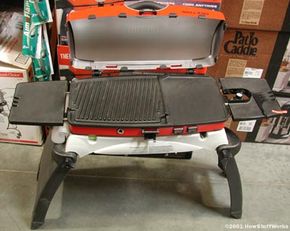Grilling Alternatives and Options
As you move beyond the basic grill design, most manufacturers offer several options to enhance your grilling abilities. Some of these options are:
- Multi-tier grills - There are grills that add a second and even a third cooking surface above the main one. Because the temperature drops considerably as the distance between the cooking surface and fuel source increases, the second cooking surface is typically used for things like steaming vegetables and keeping cooked meat warm.
- Side burners - By running a hose on a gas grill to a small burner attached to the side of the grill, manufacturers provide a way to cook sauces or other foods that need to be in a pan or pot.
- Rotisserie - This is a long metal rod suspended horizontally above the fuel source and rotated slowly, usually by an electric motor. It is used primarily for slow-roasting poultry or vegetables.
While charcoal and gas grills are the most popular, there are alternatives. The most common is electric. An electric grill has a heating element either embedded within the cooking surface or directly below it. A drip pan catches the grease and fat that cooks out of the meat. Electric grills are typically portable, and most are small enough to place on a table or countertop. Unlike gas or charcoal grills, electric grills can be used indoors.
Advertisement
Another type of grill that is catching on at the premium end of the market is infrared. Infrared grills use special ceramic-plate burners that radiate infrared heat. According to Thermal Engineering Corporation (TEC), infrared grilling does not dry the meat out and can generate a much higher temperature (up to 1,650 F / 899 C) than any other type of grill.
Be sure to check out the links below for more information on grills and related topics.
Related HowStuffWorks Articles
- How Refrigerators Work
- How Microwave Ovens Work
- How Toasters Work
- How Oil Refining Works
- How Air Conditioning Works
- How Food Works
- How Does the Lighter in a BBQ Grill Work?
- Why Does Smoke Come From a Fire?
- What Is Activated Charcoal?
- What Is the Difference Between Gasoline, Kerosene, Diesel Fuel, Etc.?
- What Does Octane Mean?
- When Buying Gas Appliances, Why Do You Always Have To Specify Whether You Are Using LPG or Natural Gas?
- What Are Hot Dogs Made Of?
- Is It True That Grilling Meat Can Cause Cancer?
